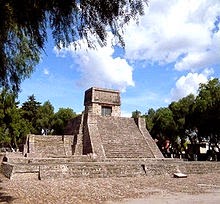The Aztecs, also called the Mexica, were part of a larger group of peoples who spoke the Nahuatl language and inhabited central Mexico. Up until 1225, the Aztecs seem to have been nomads but after that date, they settled and built cities including the city which has now become the capital of Mexico.
At first, the Aztecs were vassals of other neighboring city states but slowly, through alliances and wars, they came to rule over the others and by 1427 had created an empire.
A pyramid and temple built by the Aztecs.
Their last great ruler was Montezuma II, who in 1620 was captured by the Spanish conquistador Hernán Cortés and shortly afterwards, died. (Cortés´ generals had previously killed off most of the Aztec nobles and generals, attacking them while they were unarmed and in the middle of a religious celebration.)
The Aztecs had two emperors after Montezuma II died, but both ruled for only a few weeks, one dying of smallpox and the other, living as a captive of Cortés after the latter conquered the empire in 1621. Five years after this conquest, Cortés had him executed.
Smallpox, incidentally, killed probably one third of the Aztec population between the arrival of the Spaniards (who brought the desease to Mexico) and Cortés´s triumph.
The Aztec Empire at its height, shortly before it was conquered by Cortés.
__________________
In our documentary-in-progress, Strong Roots, Bright Flowers: Arts of Mexican Immigrants and Chicanos, we interview an Aztec drummer and watch part of an Aztec ceremony to learn more about Aztec culture. Keep up to date on our progress by going HERE.



No comments:
Post a Comment